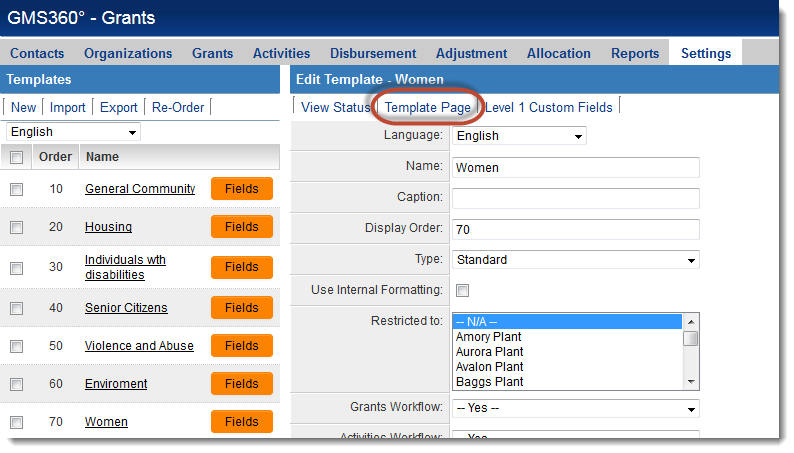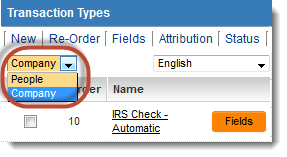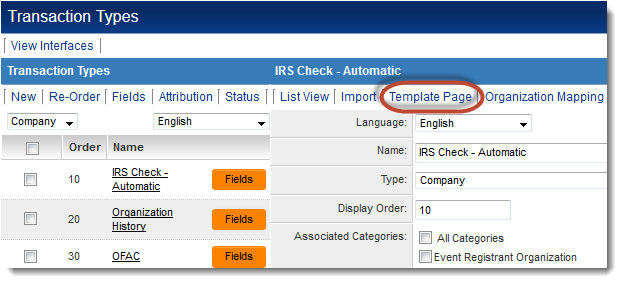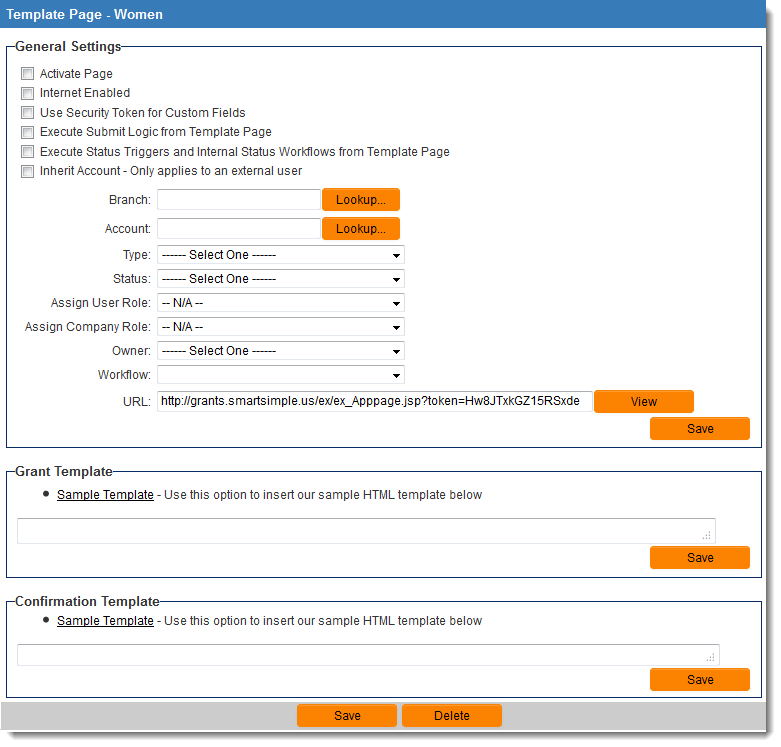Difference between revisions of "Template Page"
From SmartWiki
(→Coordinating the Formatting of the External Page with Internal Formatting) |
|||
| Line 33: | Line 33: | ||
* '''Activate Page''' - This Template Page will only be accessible if the "Activate Page" option is checked. | * '''Activate Page''' - This Template Page will only be accessible if the "Activate Page" option is checked. | ||
* '''Internet Enabled''' - Making a Template Page "Internet Enabled" will allow users who are not logged into the system to access this page. | * '''Internet Enabled''' - Making a Template Page "Internet Enabled" will allow users who are not logged into the system to access this page. | ||
| − | + | {{SecurityToken}} | |
* '''Execute Submit Logic from Template Page''' - See the [[Submit Logic]] page for more information. | * '''Execute Submit Logic from Template Page''' - See the [[Submit Logic]] page for more information. | ||
* '''Execute Status Triggers and Internal Status Workflows from Template Page''' - See [[Status Trigger]] and [[Workflow]] pages for more information. | * '''Execute Status Triggers and Internal Status Workflows from Template Page''' - See [[Status Trigger]] and [[Workflow]] pages for more information. | ||
Revision as of 13:59, 25 September 2013
Template Pages, sometimes referred to as external pages, are a feature in SmartSimple that:
- allow users to enter records in a SmartSimple UTA without having to log into SmartSimple;
- allow system administrators to configure customized formatting for UTA records;
- can be configured to include a confirmation page upon submission of the record.
Template Pages are associated with a particular Level 1 Template, Level 2 or 3 Type or Transaction.
Contents
Accessing the Template Page
To access the Template Page for a Level 1 Template or Level 2 or 3 Type:
- Go to the UTA Settings Page.
- For Level 1 Templates, click on the "Templates" hyperlink. For Level 2 or 3 Types, click on the "Types" hyperlink.
- On the left-hand list of Templates or Types, click on the hyperlink for the Template or Type for which you want to configure a Template Page.
- At the top of the Edit Template/Type page, click on the "Template Page" button.
To access the Template Page for a Transaction:
- Go to the Global Settings page.
- Under the Company & Account Settings header, click on the hyperlink for "Transaction Types".
- Choose from "People" or "Company" Transaction Types from the drop-down field at the top of the page.
- On the left-hand list of Transaction Types, click on the hyperlink for the Transaction Type for which you want to configure a Template Page.
- At the top of the Edit Transaction Type page, click on the "Template Page" button.
The Template Page Configuration Screen
The Template Page Configuration Screen contains the following settings:
General Settings
- Activate Page - This Template Page will only be accessible if the "Activate Page" option is checked.
- Internet Enabled - Making a Template Page "Internet Enabled" will allow users who are not logged into the system to access this page.
- Use Security Token for Custom Fields - enhances security of external sign-up and template pages by validating the fields that are submitted with expected values.
- Execute Submit Logic from Template Page - See the Submit Logic page for more information.
- Execute Status Triggers and Internal Status Workflows from Template Page - See Status Trigger and Workflow pages for more information.
- Inherit Account - Only applies to an external user -
- Branch - defines the default branch of the newly-created record.
- Account - defines the default account of the newly-created record.
- Type - defines the default Template or Type of the newly-created record.
- Status - defines the default status of the newly-created record.
- Assign User Role
- Assign Company Role
- Owner
- Workflow - Workflow to be triggered upon submission of Template Page.
- URL - This setting will be completed by default and includes an alphanumeric "token" which serves as a unique identifier for this Template Page.
- You will be presented with a URL in the following format:
- http://alias.smartsimple.xxx/ex/ex_Evtpage.jsp?token=HQ0NSdsAYbZFhZRBBFfQhdQ&parentids=LevelOneIds
- where LevelOneIds is the Opportunity ID of the Level 1 you will be creating these Level 2s under.
- example:
http://mysite.smartsimple.com/ex/ex_Evtpage.jsp?token=HQ0gNSAYbZfdhFhZRBBFQhdQ&parentids=5551234
HTML Template
- This section may be renamed to match the terminology of your copy of SmartSimple. In the illustration above, HTML Template has been renamed to Grant Template because Level 1s have been renamed as "Grants" in this example.
- Clicking on the "Sample Template" hyperlink will insert a default HTML template into this setting, overwriting the current contents.
- See the Template Page - HTML Template for examples of implementation.
Confirmation Template
- The Confirmation Template will be displayed after the Template Page is submitted by the end user. Variables such as sslogic can be implemented in this setting to present different confirmation pages depending on how the external page is completed.
- Clicking on the "Sample Template" hyperlink will insert a default HTML template into this setting, overwriting the current contents.
- See the Confirmation Template page for examples of implementation.
Coordinating the Formatting of the External Page with Internal Formatting
- By default, the Level 1 external page will not pick up the formatting of the internal page (for example, Title Bars configured as tabs will be displayed as simple Title Bars).
- To use the formatting defined within SmartSimple for the external page, enable the "Use Internal Formatting" setting on the Template Settings page.



